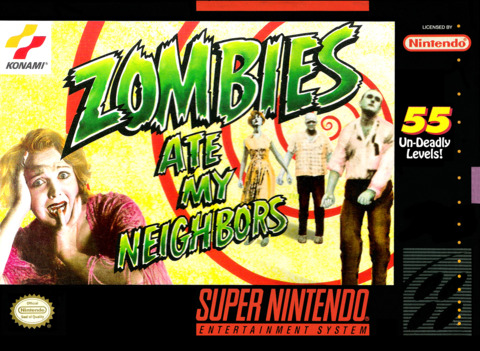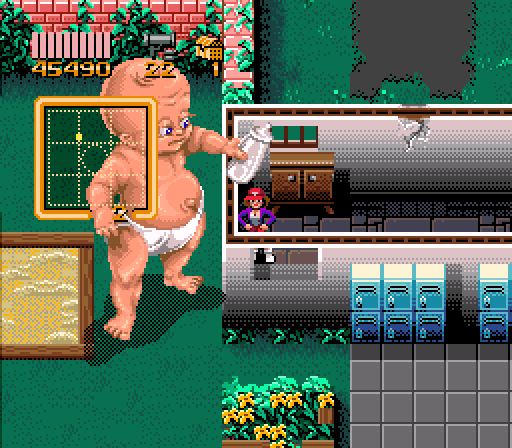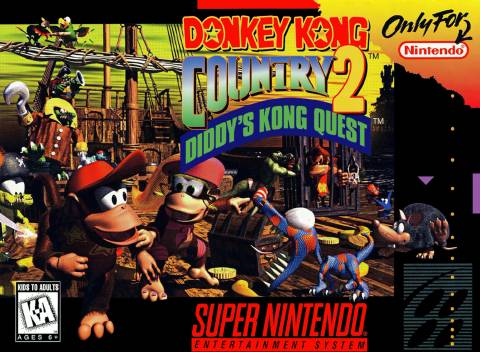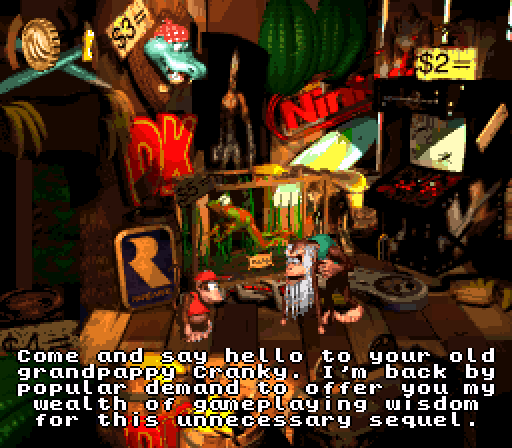The SNES Classic Mk. II: Episode XXII: ROM-Zom-Kong
By Mento 0 Comments
The SNES Classic had a sterling assortment of games from Nintendo's 16-bit star console, but it's hardly all that system has to offer a modern audience. In each installment of this fortnightly feature, I judge two games for their suitability for a Classic successor based on four criteria, with the ultimate goal of assembling another collection of 25 SNES games that not only shine as brightly as those in the first SNES Classic, but have equally stood the test of time. The rules, list of games considered so far, and links to previous episodes can all be found at The SNES Classic Mk II Intro and Contents.
Episode XXII: ROM-Zom-Kong
The Candidate: LucasArts' Zombies Ate My Neighbors

I couldn't leave October without at least one horror-themed game, and there aren't a whole lot of those available on the SNES. I mean, there's Clock Tower and Laplace no Ma, but I'm not sure I have the patience for either right now. Fortunately, Zombies Ate My Neighbors is the antithesis of the usual sort of horror game that are slow and deliberate and build the tension gradually only to pop it like a balloon with a well-timed jumpscare. ZAMN ain't about that. ZAMN's about running around top-down levels getting attacked by a dozen classic B-movie monsters from every direction.
Zombies Ate My Neighbors is the creation of LucasArts, which has something of a track history when it comes to letting aesthetics guide their games rather than the usual inverse. Though the genres might change, each of LucasArts's games are marked by an adherence to certain cinematic conventions: they're built around and for their affection for pulpy movies, as shared by their namesake director George Lucas, and particularly sci-fi genre fare of the early- to mid-20th century. ZAMN takes its inspiration from a huge number of 1950s B-movies, many of which were originally 3D (it's why Zeke has those glasses, after all), and when coupled with its deliberately arcade-style run-and-gun action it's the type of game that never seems to sit still for long. Each level swings wildly from undead to UFOs to pod people to masked chainsaw maniacs to living dolls swinging axes; there's a certain cartoonish art consistency to these enemies but no real heed given to continuity or franchises. A level might have a Count Dracula and the Wolfman sharing space with Chucky and Jason Voorhees, depending on how busy it is.
The crux of the game is to rescue the eponymous neighbors from monsters, be they zombies or otherwise. Monsters continually respawn, so there's little point in standing your ground and fighting them all off especially as all your weapons have limited ammo. Instead, you're expected to use the short-range radar and explore the level for your fellow humans before they all get munched or beheaded or disintegrated by ray guns. This often requires navigating the maze-like levels to find the right path to them, and taking detours to collect rare items you might need for later levels or weapons to use against certain foes resistant to your default holy water super soakers. Once all the neighbors have been rescued, an exit door automatically appears near the player and they can move on. Completing every fourth level provides a password for replays, and there's also the occasional boss fight and bonus level to find.
What I've yet to cover is the game's relentless difficulty. True to its arcade spirit, ZAMN takes every low road it can to screw you over or deny you opportunities to easily continue. You do have a generous health bar - ten pips, and most enemies only do one hit point of damage per collision - and a means to recover it with semi-rare first aid kits, but for the most part you have to be cautious when moving around in case enemies spawn directly on top of you. Enemies can move extremely quickly - especially the first boss, a giant toddler, and the Martian UFO invaders - and it's often more trouble than it's worth to eliminate enemies when you can just run past. Compounding the difficulty further is how extra lives are tied to how many survivors you've saved - hitting point totals replenishes deceased survivors, as their numbers remain static from level to level (so if you only saved eight after one level, there'll only be eight on the next), and only if you have the max number of survivors will these point milestones reward extra lives instead. Far as I can tell, there's no other way to replenish any lives lost, and once you've lost all three that's game over. You can use passwords to get back to where you were, or at least the closest multiple of four, but at that point you're starting over with a fresh inventory and none of the useful items you may have found.

Your inventory is another aspect to ZAMN which requires some degree of mastery before it'll become useful. Found objects are sorted into two categories: weapons and items. Depending on the monster, the weapons you find will be more effective than others; the dolls, for instance, really don't like it when you throw cans of what appear to be soda at them. The items can include curatives and buffs and a decoy to distract enemies pursuing you. Learning what they all do is the first major step to using them effectively; the second is knowing what you're up against and what you'll need to defeat or deter them. Provided you aren't hitting game overs regularly, you'll end up with a big stockpile of many weapon types to use when the right enemies show up again. However, the irritating part is that you have to cycle through weapons and items alike when in the field, and the game never pauses: you better hope you don't cycle too quickly and end up passing the item you sorely need that moment. It doesn't help that the designers couldn't find a way to display how many keys you might have on the UI somewhere, so instead the keys are also part of the item cycle reel as one more thing to distract you (keys are automatically used when you touch a locked door, so it's not like they need to be in that menu).
All of this adds up to make ZAMN the kind of game you're not going to master in a day. Even if you try to brute force the thing with passwords, you'll be more and more disadvantaged the further you get in as you start with barely any items and only the default weapon, which many late-game enemies are immune to. Having two players might help, except at that point you're sharing resources and there's not a whole lot of valuable items like first aid packs to go around. Sometimes the enemies are so relentless and/or fast that you can't help but take a lot of damage. That's true also of environmental hazards like the constantly growing spiky plants or the spike traps in dungeon stages. Though it frames itself as an arcade shooter, it's really more of an endurance game: memorize the stages (this is where the passwords are most useful), save as many neighbors as possible by taking the most efficient route that prioritizes those most in danger first, scavenge for items wherever possible and build a repository of weapons and items for the levels where they're sorely needed, and try not to die. I think I underestimated how long it would take to complete it, so I might have to come back to it later.
Between its cult appeal and spooky mood-setting, I imagine there's no small number of people who drag ZAMN out of their closet and play it around Halloween every year, coasting through on muscle memory and hoping this year is the one where they finally defeat Dr. Tongue at the end of the game. Instead, they get caught up short by the "snakeoids" on level 20 and miss the brass ring, and with a rueful smile that player packs it all away for next Halloween. Had I first encountered this game at much younger age when I would've been more patient with its particular brand of antagonism, that person might well be me.
When I wasn't getting constantly ganked by the cast of Tremors, did I enjoy the game? Does it hold up? It's time to check in with some flying saucers of a different sort - the P.O.G.S.:
- Preservation: The extreme difficulty might be a bit too much for a modern audience, and the issue is that it's very uneven and arbitrary. Levels are designed in such a way that you'll see peaks and troughs, presumably so you can recover your item supplies and health after a particularly nasty encounter or a boss, but it also makes the game unpredictable unless you've played it a few times and can anticipate when and where these high-challenge encounters occur. It does serve to make the game more fun to progress through on a blind run, however, as you're never quite sure what's coming up next. 3.
- Originality: I have to hand it to this game, it's about one of the most distinctive games for the platform. There are a fair number of top-down shooters on the platform of course - Super Smash TV, The Twisted Tales of Spike McFang, Operation Logic Bomb, the Pocky & Rocky duo - but few are designed around rescuing victims and fighting off endless hordes of classic movie monsters with their own attack patterns. The improvised weapons, the "They Came From Space!" style marquees before each level, the little tricks and tactics you pick up while playing (like how the powerful bazooka is often better used to blast holes to new areas rather than on monsters); it's far more than the sum of its parts. 4.
- Gameplay: There's a lot to appreciate in terms of weapon and item variety, not to mention the wide number of monsters and other challenges you'll face from level to level, but it still all boils down to endlessly respawning enemies, mazes, and people to rescue. None of those elements have really ever made for a great gaming experience, as every moment is either spent stressing over getting to the victims in time and losing too much health because you're too pressed for time, or getting lost because the layout is confusing or there's a key you haven't found yet. The accelerated speeds of some monsters isn't all that fun to deal with either. You can tell the same people were behind the Super Star Wars games, which also were too darn challenging for their own good. 3.
- Style: It's very hard not to immediately fall in love with what ZAMN is doing with its aesthetic. It's a very affectionate nod to the types of movies that have always been the chief source of LucasArt's unique vision, from the groovy teen horror of Maniac Mansion to the genre silliness of Zak McKracken and the Alien Mindbenders. The same could be said for Star Wars itself. Even if you aren't familiar with the B-movie tropes and many years of movie monsters it draws from, the game's lighthearted though grisly art direction is enough to clue you in on what it's going for. 5.
Total: 15.
Other Images:
The Nominee: Rare's Donkey Kong Country 2: Diddy's Kong Quest

Ah, here we have the latest episode of a mini feature-within-a-feature called "Yeah, No Shit." Yeah, No Shit is proud to introduce the - many would say superior - sequel to Donkey Kong Country, which was included on the original SNES Classic. It might be a bit gauche to put too many sequels on the second SNES Classic for games that were on the first, but I've made an exception here because of how much the second game expands on the original. Besides perhaps the soundtrack, because I find it nigh-impossible to choose between DKC1's Aquatic Ambience and DKC2's Stickerbrush Symphony, DKC2 is improved in almost every way by dumping its titular ape for the more versatile combo of Diddy Kong and his Princess Peach-esque hovering girlfriend Dixie Kong, adding more collectibles and more branches to the game progression, being generally better to look at though you can only go so far with 16-bit pre-rendered CGI, and is overall more thematically diverse, and has been otherwise tweaked and upgraded to a more Platonic ideal of what a barrel-throwing monkey platformer could be.
That paragraph ended up being a little more conclusive than I had planned. I generally try to pitch each SNES game with around 500 words, but that might be all the material I need. For the sake of... well, let's say "listening to my own voice", I'll expatiate a little further with some details and history. Donkey Kong Country 2 is the second of three SNES games produced by UK developer Rare (the last time in this feature I'll be invoking a local developer, incidentally; it's all Japan-only from here on out) with Nintendo's Donkey Kong license. Donkey Kong spent a little while in the ether there after the third arcade game, and by "ether" I'm not just talking about the clouds of toxic pesticide sprayed at him by Stanley the greenhouse worker. Eleven years passed between Donkey Kong 3's debut in 1983 and Donkey Kong's big comeback in 1994, where he appeared in perhaps two of his best ever games: a surprisingly robust reboot on Game Boy simply called Donkey Kong (though fans usually call it Donkey Kong '94) and the first Donkey Kong Country for SNES. The latter of which was followed up by this, Donkey Kong Country 2, released the following year in 1995's holiday season.
Donkey Kong Country was considered by many reviews at the time as an impressive achievement, though a lot of that critical attention went towards the game's "revolutionary" pre-rendered graphics which imitated 3D without necessarily being so. The gameplay itself was variably described as "extremely difficult", "extremely frustrating" and "extremely dependent on annoying minecart levels". However, DKC did exhibit a lot of creativity with the variation of challenges it tossed the player's way, as tough as they were. Levels where you'd have to keep the lights on by hitting torch barrels because the dark would awaken tough monsters, or moving platforms that regularly needed gasoline to keep functioning or else they would toss you into the bottomless pits below. There was a significant amount of repetition of these ideas, of course - you even got used to seeing the same bosses show up with a fresh coat of paint - but for the most part its appeal hinged on never being quite sure what would appear next. That's what DKC2 saw as the heart and soul of the franchise, adding even more levels built around a gimmick of some kind, whether they were aerial stages with Squawks the Parrot or barrel mazes in bramble thickets or a carnival roller coaster that seemed suspiciously similar to the minecart levels of the previous game.

It is the nature of video game sequels to be bigger and better than their predecessors in every respect. This is largely due to how much a game is frequently a mechanical enterprise as much as it could be considered an artistic one: if you built a machine that didn't quite fulfill its purpose with maximum efficiency, you'd take that experience and build a better "Mk. II" from what you'd learned. DKC was a strong game, but had identifiable flaws that the developers were able to correct to some extent, leading to a sequel that I feel outshines the original in every regard. The only major issue is that it was fairly late to arrive on the platform: the original had the good luck to arrive in North America months before its "amazing" graphics would be eclipsed by the Sony PlayStation and Sega Saturn's more genuinely 3D boxy offerings; a fortuitous bit of timing that the DKC sequels would be denied. Thus, the first Donkey Kong Country was the far better choice when constructing a miniature console "classic" built specifically to pander towards the deeply nostalgic. I've more or less sidestepped that raison d'etre for my hypothetical SNES Classic, focusing more on the SNES games that deserve a new lease of life instead.
A better Donkey Kong Country sounds like an enticing prospect, but we'll see if the notorious P.O.G.S. can back that up:
- Preservation: DKC games have this sort of momentum to the movement that takes a while to adjust to, and the advanced tech like rolling off a platform and then jumping in mid-air is some unintuitive horseshit, but for the most part these games still hold up if you like your 2D platforming cruel and intense. Graphically it's a different matter, but while pre-rendered CGI has aged about as well as a fine wine that was drunk out of the fake Holy Grail, DKC2 has a strong art direction that makes up for it. Lots of colors, some nice backdrops, attractive filters like rainfall and other environmental effects, some cool use of the foreground and background layers; far from the aesthetic equivalent of throwing salt in your eyes, in so many words. 4.
- Originality: Obviously a sequel is somewhat compromised in this category, especially if the predecessor was highly regarded and no-one making the follow-up wanted to deviate too far from a tried-and-tested successful formula, but DKC2 does take risks and goes for more level ideas than the previous, as well as a number of different themes and a whole secret set of levels that you have to unlock. It's not quite the procession of linear levels that DKC 1 was, but not too far removed from that either. I'm inclined to give it a point for having a sequel where the eponymous character has vanished: this and Mario is Missing (and I guess literally every Zelda game) are the only examples that come to mind. 4.
- Gameplay: I think you'd be hard-pressed to find a better platformer for the system that didn't come from Nintendo or HAL directly. Maybe something from Konami. DKC2 does have a learning curve to the way it plays and you sort of have to figure out the game's wavelength at times and be prepared for a lot of deaths, but it's the sort of game where you start to enjoy it more the better at it you become. Once you're in the rhythm of those rolls and leaps and knowing the sorts of distances and heights your jumps will reach, it's easier to navigate the tougher levels. Of course, a lot of the time you aren't doing much platforming at all: you're stuck in a minecart or being flung around by barrel rockets and you have all-new gameplay rules to observe. That's neat in its own right too, I reckon. 4.
- Style: Oh boy, this might get a little controversial. I think the graphics are a wash; the visual style and more static environments are exceptional, though the blurry pre-rendered characters makes it look like someone had to mosaic them all out of the scene, like an episode of Cops were nobody was signin' nothing that a film crew gave them because that's how they get you, man. What elevates this to a maximum score, then, is the David Wise soundtrack for what I hope are obvious enough reasons. There's just something straight up otherworldly about that guy's music. 5.
Total: 17.
Other Images:
















